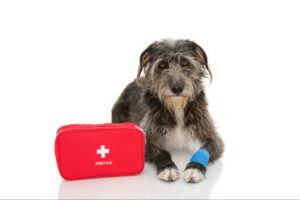In a world of dangers and accidents, it is not uncommon for dogs to be injured by burn wounds on their skin. Caused by thermal heat, electrical devices, or chemical solutions, burns on dogs can occur at any time both at home and in new environments. If you want to protect your dog and give him the best possible care after such an injury, it’s important to understand how to care for burns on dogs and what process takes place when you visit the vet.
Because burns on dogs is a serious injury, it’s important to provide medical attention immediately to avoid complications and ensure a speedy recovery. Today, we’ll cover the details on how to care for burns on dogs, as well as how your local veterinarian will treat the burn wounds.
While burns on dogs are a serious condition, there is no need to panic as long as you know how to properly treat the wound. Read on to learn how to care for burns on dogs and the different types of burns on dogs to be aware of.
How to Care for Thermal Burns on Dogs
There are three main types of burns in dogs: thermal burns, electrical burns, and chemical burns. Each one of these burns can be broken down into three different categories: superficial burns, partial-thickness burns, and deep burns.
Superficial burns, which involve the outermost layer of skin, are comparable to a human’s first-degree burn. Partial-thickness burns, which affect the epidermis and the outer layers of the dermis, cause blistering similar to second-degree burns in humans. The final type of burn, deep burns, damage the epidermis, dermis, and subcutaneous tissues, causing a wound similar to a human’s third-degree burn.
Superficial Thermal Burns
Superficial thermal burns can be treated by immersion of the affected skin in water or by applying an ice pack. After rinsing the wound, remove any hair or debris from the burn and gently pat dry. Do not use oil-based medications on a burn wound. A non-stick telfa pad can then be applied followed by a light bandage to hold it in place. If the burn wound becomes infected or is not healing, veterinary care is needed.
Deep Thermal Burns
Deep thermal burns extend below the surface of the skin and require immediate veterinary care. While waiting for your veterinarian, you may treat the wound by placing a cloth loosely over the burn area. Do not rinse with water or place any medications in the wound. Because these wounds are very painful, some dogs may even go into shock.
How to Care for Electrical Burns on Dogs
Electrical burns are usually the result of a dog biting into an electrical cord. Although these burns are usually seen on the lips and tongue, the dog’s entire body receives an electrical shock. If you see your dog bite an electrical cord, do not touch the dog or try to pull the cord from its mouth, as you may get shocked. Instead, pull the plug from the outlet and check for breathing and a pulse in your dog. If breathing or the heart has stopped, you may need to perform CPR.
After any electrical burn or shock, seek immediate veterinary care. Even if your dog appears fine, there is a possibility that complications may occur.
How to Care for Chemical Burns on Dogs
Chemical burns (acid or alkali compounds) may occur on the surface of the body or may be ingested. To care for a chemical burn on dogs, rinse the chemical off with water as soon as possible. If the compound is an acid, you may also rinse the area with baking soda dissolved in water. Vinegar and water may also be used only if the compound is alkaline.
If your dog ingested the compound, check the container to see if there is an antidote and seek veterinary care immediately.
How Your Vet Will Treat Burns
No matter the level of severity of the burn, medical attention should be provided by your veterinarian as soon as possible. Your vet will monitor your dog’s blood pressure, as well as perform a number of diagnostic tests to ensure no complications arise during or after treatment.
How your vet will treat burns depends on the severity of the burn and the type of burn received. In most cases, your vet will clean the wound and apply bandages with dressings. To prevent dehydration in the dog, your vet will likely hook up IV fluids to the canine. If the dog’s mouth was affected by the burn, your vet will flush the mouth with water and provide medication to prevent infection.
Because infection is a major concern, your veterinarian will treat the wound with topical creams as well antibiotics to prevent infection from occurring. Additionally, your vet will likely give your dog painkillers, as burn wounds can be extremely painful.
A number of tests will be performed during your dog’s hospitalization. Depending on the severity of the burn wound and your dog’s reaction to it, your vet may need to treat your dog for shock. Tube feeding may be necessary if the dog is unable to eat. For dogs unable to stand, your vet may re-position him every few hours to prevent bed sores.
Before your dog comes home from the veterinary clinic, your vet will likely prescribe painkiller medications and topical creams for the burn wound. If your dog was internally affected by electrical burns or chemical burns, your vet will prescribe medication to promote the healing of mucous membranes in oral cavities.
How to Prevent Burns on Dogs
There are a number of precautions dog owners can take to prevent burns on dogs. Watching your dog closely and removing dangerous objects are just a couple of ways burn wounds can be prevented. Here, let’s take a closer look at how to prevent burns on dogs.
Watch Your Dog Closely
Dogs are curious animals and thus get into trouble easily. To prevent a burn accident from occurring, dog owners should watch their pups closely. If your dog is in a new environment, he should be kept on a leash or remain by your side at all times.
Make Sure Dangerous Objects Are Out of Reach
As a dog owner, it is your responsibility to keep dangerous objects out of reach from your pup. Always keep chemicals locked up in a secure location, and keep your dog back when using electrical devices. If you have an open fire, such as a campfire, you may need to block off the area to prevent thermal burns in dogs from occurring.
We hope this article has helped you identify the different types of burns on dogs and how to properly treat them. Remember, seeking medical attention from your vet is the most important step when treating burn wounds in dogs. By visiting the vet after a burn wound, you can speed up the recovery process and even save your dog’s life.











